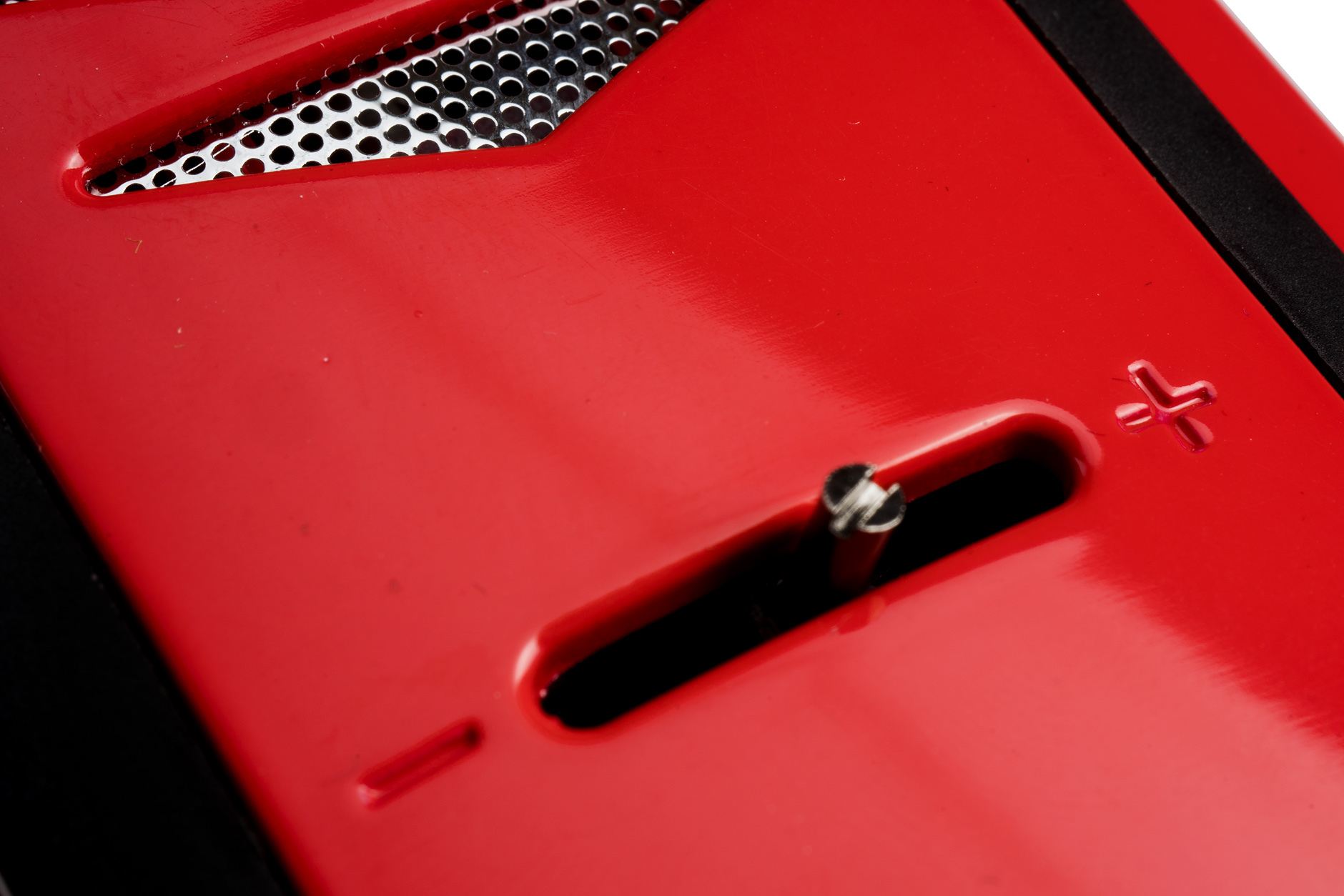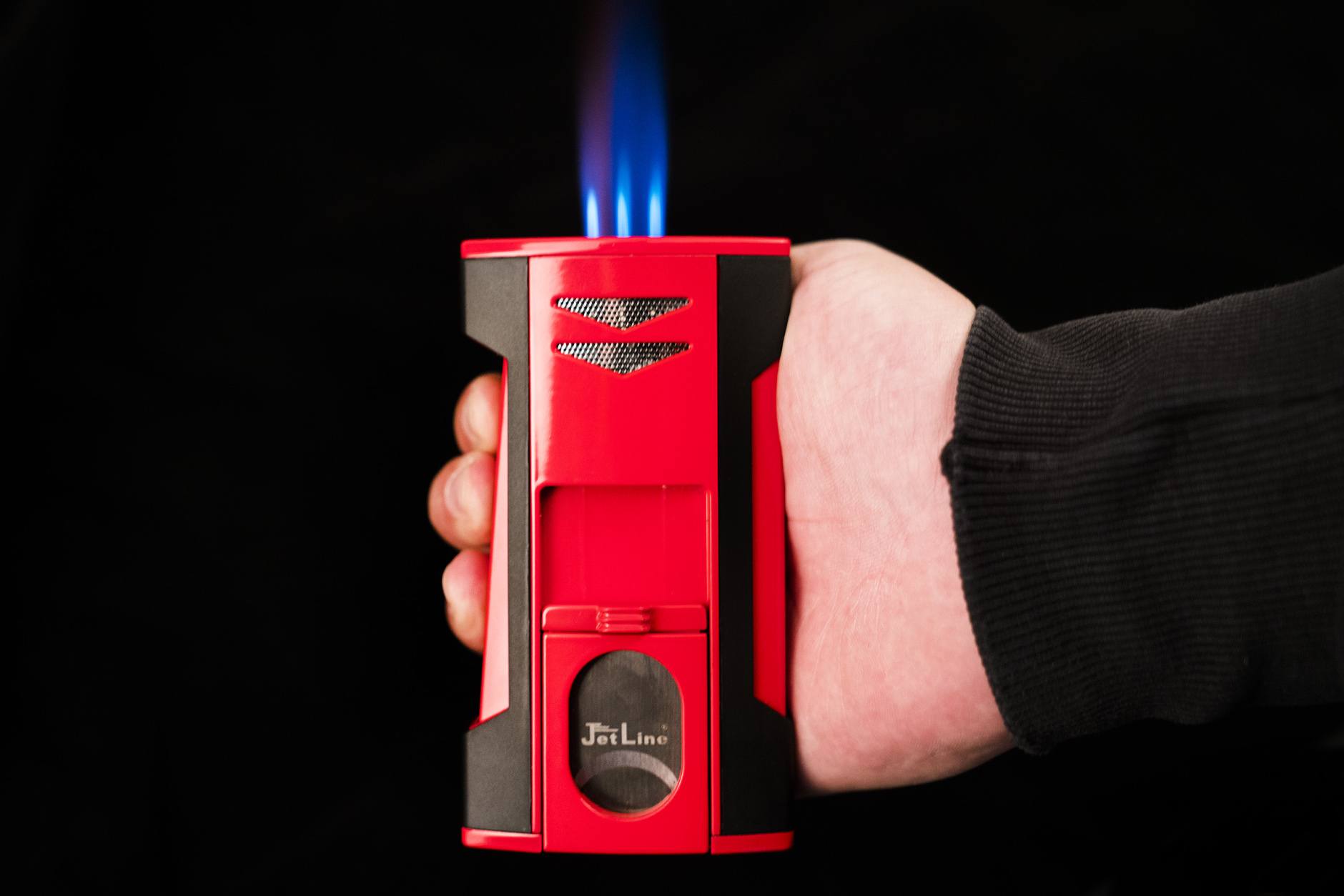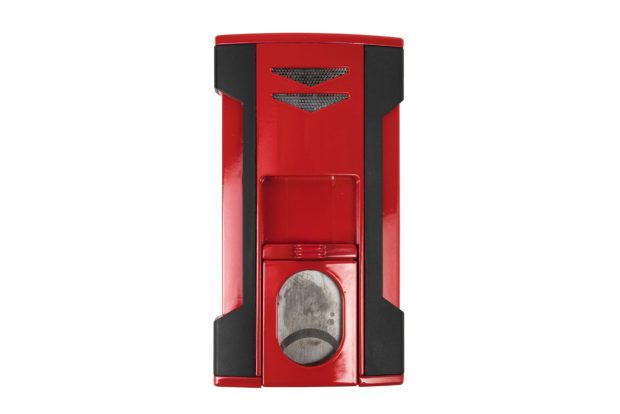Sometimes the main selling point of a product comes right out and almost smacks you across the face with its obviousness, as the JetLine V-6 lighter does as it sits in a display case alongside its much smaller brethren. The company goes so far as to call it a “beast of a lighter,” and it’s easy to see why, as not only is it big, it packs a whopping six jet torches under the hood, giving it one of the largest flame bases of any lighter on the market, if not the biggest.
While the V-6 debuted at the 2016 IPCPR Convention & Trade Show, it didn’t become widely available until earlier this year. It measures 4.75 inches (121mm) tall, just under 2.5 inches (61mm) wide and a bit more than an inch (30 mm) thick at its widest, while weighing in at 13.4 ounces, the heaviest lighter we’ve reviewed by a significant margin and the only one that would qualify for USPS Priority Mail on its own, largely due to an all-metal body, though the black accents appear to be made from plastic.
| Name | Weight (Grams) | Weight (Ounces |
|---|---|---|
| Bugatti Vulcan | 166 | 5.8 |
| Colibri Boss II | 120 | 4.2 |
| Fuego Robusto | 136 | 4.8 |
| JetLine Super Torch Triple | 50 | 1.7 |
| JetLine V-6 | 380 | 13.4 |
| S.T.Dupont Initial | 99 | 3.5 |
| S.T. Dupont MaxiJet | 62 | 2.2 |
| S.T.Dupont miniJet 2.0 | 59 | 1.9 |
| XIKAR HP4 Quad Lighter | 132 | 4.7 |
| XIKAR Linea | 66 | 2.3 |
| XIKAR Xidris | 92 | 3.2 |
As far as appearance, the V-6 has an oversized, almost novelty appeal to it, but it is a decent looking lighter. A pair of triangle shaped, mesh covered air vents on each side of the lighter give it some decoration and function, while the vertical accents play up the lighter’s size.
Size aside, the lighter has a rather familiar design, almost too familiar given some obvious similarities to the S.T.Dupont Défi Extrême. It’s a side squeeze, single action ignition; with the cutter facing you, the left side of the lighter is the side that squeezes in to pull back the two panels that cover the jets, begins the flow of fuel and fires the ignition spark. I found this to be a bit backwards as I kept wanting my right thumb to push the ignition in, as opposed to the fingers. The simple solution is to turn it around, which I did most of the time, but the first week or so was a bit frustrating as I tried to gain some new muscle memory.
The ignition is fairly reliable but showed the most misfires of any lighter I’ve used in recent memory. There didn’t seem to be an inherent reason for this, as even slowing down the ignition process wasn’t a certain cure, though it did seem to help here as it did with other lighters I have reviewed.
Once lit, the V-6 shows what really makes it different from the completion. I’d assume most people reading this have used a triple flame torch lighter, and some have used a quad-flame lighter, while a handful may have used the five-flamed Rocky Patel Diplomat, a thick cylinder of firepower that had previously held the title of most jets in a lighter. In the case of the JetLine V-6, the lighter is built around two rows of three jets that are angled inwards in a long, inverted v-shape, about an inch wide, or the width of a 64 ring gauge cigar. It’s also fairly loud as fuel is pumped out of the jets and ignited.

When it comes to adjusting the flame, the JetLine V-6 shows one of its unique aspects, using a horizontal lever on the back of the lighter to adjust the flame as opposed to the traditional mechanisms on the bottom, whether it be the increasingly common large wheel that can be adjusted with your fingers, or the smaller, more traditional design that requires a screwdriver or similar tool, even though it appears to be one on the base of the lighter, where the fuel valve is. It doesn’t turn so don’t even bother with it.
With the lever at the far left, the lighter will not ignite and there doesn’t seem to be any fuel flowing. In fact, for the first third of the travel distance of the lever, there doesn’t seem to be any fuel flowing, relegating that section to relative uselessness, other than helping make sure the V-6 doesn’t ignite accidentally.

Move the lever to the right end of the spectrum, however, and expect the biggest show of fire you’ve likely seen from a cigar lighter, though Blazer’s more recent offerings, which are geared towards marijuana smokers as the company has seemingly moved on from cigars, are similarly impressive by way of a huge single flame. The flame extends easily five to six inches above the top of the lighter, perfect for lighting a 70 ring gauge cigar from a foot away. That is with regular fuel, as well; fill this up with XIKAR’s High Performance Butane and expect even more of a show.

Over the several weeks I used the JetLine V-6, I found that the ideal setting tended to be right around the midpoint, which is where enough fuel flows to create a steady, manageable flame. A bit to the left and there’s sputtering, a bit to the right and there’s flame overkill for anything under a 60 ring gauge cigar. While you can certainly light slender cigars with the V-6, it does require a bit more awareness and dexterity to avoid scorching the sides or overly torching the foot.
One of the first issues I noticed about the JetLine V-6 presented itself after lighting a few cigars: after releasing the ignition, the lid doesn’t close completely about half the time.
The V-6 also features a safety mechanism that prevents the lighter from igniting when the lighter is turned more than 90 degrees, though if you squeeze the ignition you’ll still hear some fuel flow out. There’s no other mechanism to lock the ignition, which I found a bit surprising, though given it’s not designed to be a pocket lighter, I can understand. What would concern me about this lighter—and any lighter for that matter—is a child managing to ignite it. There is some resistance to the ignition, though I don’t want to underestimate the strength of a motivated youngster.
On the front of the lighter is a double guillotine cutter, though only one blade moves. Additionally, the cutter is fixed in place, meaning that it doesn’t fold out like cutters on what you might have seen on the Colibri Astoria, for instance. This, plus the size of the V-6, results in needing to find both leverage and convenience from the cutter. The handful of times I tried the cutter, I generally held the cigar between my left thumb and index finger while stabilizing the base of the lighter with the rest of my left hand. My right hand curled around the top of the lighter, with my thumb used to slide the blade through the cap.
Using any cutter results in debris to deal with, and the JetLine V-6’s is no different, however here it goes behind the blade as well as scattered on the front side as well. It’s a bit of a mess, though you can certainly shake the cap and crumbs into an ashtray, but don’t expect it to be as tidy as using a standalone cutter that you can hold over an ashtray.
While the blades seem to be fairly sharp and the cuts were clean, this would certainly be a last resort—especially as a fan of cigar scissors—where the visibility and control is much better than what the JetLine V-6 affords. Even though it’s usable and functional, there’s a side of me that would have preferred this to just offer a simple punch cutter.
One thing that is noticeably missing from the JetLine V-6 is a visible fuel window, which in the case of this lighter is a real shame. As you might have guessed, the JetLine V-6 goes through fuel incredibly fast, and if you choose to make this your regular lighter, you will have to readjust your expectations for how frequently you will be refilling it. This is supercar level of fuel consumption, so if you buy the V-6, buy the big can of fuel and don’t complain about the price of gas or how often you’ll fill it. The company hasn’t made any statements about the fuel capacity, though I think if they did it would be almost irrelevant. You can only put so much fuel in a lighter and the V-6 will go through it quickly.
Ever since I first heard about the JetLine V-6, I’ve had it on my radar as a lighter I wanted to review, both for the seeming novelty of six flames but also to see how practical it was were I to make it my everyday lighter.
In terms of portability, you can certainly take it with you, but it’s not something I want in my pocket, as it’s more than twice as thick as my iPhone in a protective case, not to mention a good bit heavier. If you have a plastic travel humidor, it’ll need to be at least a ten-count for it to fit, so be prepared to give up some space. I did take it on the road a few times, and the paint has a pair of very small nicks to show for it, but otherwise it has held up well. However, given the rate of fuel it consumes, you’ll want to make sure to pack some butane as well if you plan on taking it on an extended trip. Personally, I’d rather have three JetLine Super Torches in any number of flames, or any of the company’s similar lighters such as the Patriot.
In terms of practicality, this is just too much lighter for me. I’ve never been one to be showy with my lighters, and I don’t smoke enough 60-plus ring gauge cigars to merit such a lighter, let alone feeling like any of my army of triple flames couldn’t do an adequate job.
The V-6 was one of several JetLine products show off in 2016 that I didn’t expect to see from the company that I knew for making pocket-friendly, $10 lighters. This is the same year the massive Baron tabletop cutter first appeared with its $280 price tag, along wit the slightly more affordable Ganon cutter and the Argo, a seven-cigar cylinder-shaped travel humidor priced at $150. All of them just seemed like too much, which is how I feel about this lighter.
While functional, I feel like the JetLine V-6 crosses the line of just how many jets and how much flame a cigar smoker really needs. Yes, it makes quick work of anything you put in front of it, but I don’t think that’s always a great thing. Even with the prevalence of multiple jet torches, there is still something ritualistic and enjoyable about slowly toasting a cigar, not to mention that it helps minimize char and over-lighting the tobacco, which in turn preserve the flavors of the tobacco and make the cigar that much more enjoyable. While I’ve never found a lighter capable of improving the flavor of a cigar, I think the V-6 is the most capable of adversely affecting it among the lighters I’ve used.
Beyond the aforementioned issues about a lack of a fuel window and the butane consumption rate, I was also a bit disappointed with the inconsistent closing of the lid, which while not a huge issue, I would expect not to have from a lighter that is priced in the three digits. Similarly, it sounded like there was something loose inside the lighter, and while I didn’t spend much time shaking it, it would make sporadically make some noise, which again, I don’t think should be something found in a lighter of this price.
Kudos to JetLine for pushing the envelope and creating a lighter that’s been fixed in my mind for two years. Though after six weeks of daily use, I can say with confidence that it will soon be fixed on a shelf.
The JetLine V-6 is available in either red and black or gray and black, both with an MSRP of $129.
The lighter used in this review was purchased by halfwheel.













